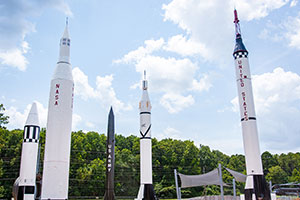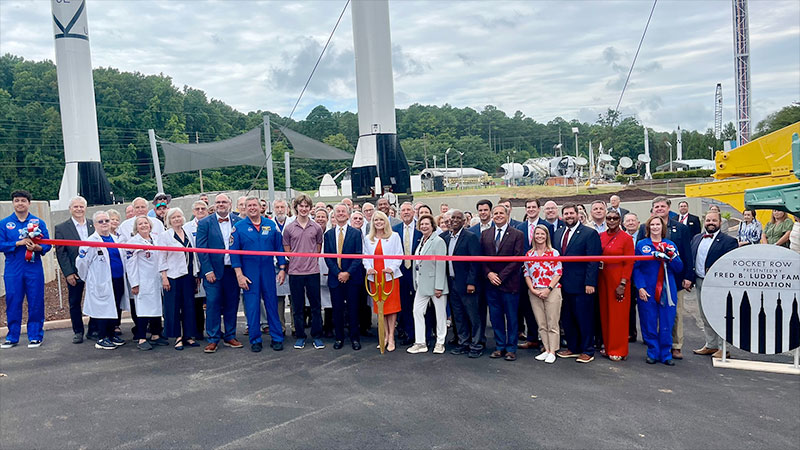 advertisements advertisements
|

|
Rocket Row ribbon cutting marks return of rocket center's 'spaceline'
July 18, 2024 — Some cities have skylines. Huntsville, Alabama has a "spaceline." Or so it does again with the restoration of "Rocket Row" at the U.S. Space and Rocket Center.
On Thursday (July 18), a ribbon cutting ceremony was held at the center's Rocket Park to mark the first stage of the return of its historic boosters. After being lowered in 2018 to be restored off site, all five historic rockets are standing again.
"These historic artifacts have welcomed millions of visitors, serving as tangible symbols of humanity's journey into space," said Kimberly Robinson, CEO and executive director of the U.S. Space & Rocket Center. "Originally intended for active space missions shortly after assembly, these rockets have since stood proudly on display for over five decades, enduring the passage of time and the elements."
"However, the years finally took their toll," she said, "necessitating a critical need for restoration to preserve these priceless artifacts for future generations."
The founder of a cloud computing company and father of a Space Camp attendee at the rocket center heard of the rockets' plight and donated $2 million towards the effort.
"Fred [Luddy] saw the condition of our historic rockets and was concerned. He generously offered and we gratefully accepted a major gift that launched the restoration of Rocket Row," said Robinson. "We are so grateful for his servant's heart. A heart that led him to help out our small center and keep the legacy of these rockets alive for future generations."
Visitors to the center will soon be able to tour through the newly rearranged and expanded Rocket Park, which includes U.S. Army Redstone, Jupiter, Jupiter-C, Juno II and Mercury-Redstone rockets. The five Chrysler-built vehicles, which were installed before the museum opened in 1970, represent the Redstone family of rockets that led to the development of the Saturn I and, ultimately, Saturn V that launched NASA's Apollo astronauts to the moon.
The dedication ceremony came two days after the 55th anniversary of the launch of Apollo 11, the first lunar landing mission with astronauts Neil Armstrong, Buzz Aldrin and Michael Collins. Rocket Row also includes an authentic Saturn I, which was restored in place. Nearby, a replica Saturn V stands outside the Davidson Center for Space Exploration, which houses one of the three moon rockets still in existence.
Brooks Moore, a member of the U.S. Army's rocket development team and a long-time docent at the rocket center, tapped into his personal history to provide advice on the redesign of Rocket Row. He died in April at the age of 97.
"I wish he could have been here today to celebrate with us," said Robinson. "I am so happy that Brooks' directions have now been cast in steel and concrete."
Cosmos Aerospace in Cullman conducted the rockets' restoration, which included repairs and repainting. The Juno II, for example, now displays the livery of the 1959 rocket that launched Pioneer 4, the first U.S. probe to escape Earth's gravity and perform a flyby of the moon before entering heliocentric orbit.
The Mercury-Redstone rocket on display was returned to the same white and black markings it had when it "flew" on Nov. 21, 1960. The booster was intended to lob an uncrewed Mercury capsule on a sub-orbital flight, but after raising just four inches off the ground, it shut down and settled back on the launch pad (the capsule then fired its escape tower and jettisoned away).
New to the Rocket Park is the engine section from NASA's Space Launch System (SLS) core stage pathfinder, an engineering simulator that was built to match the size, weight and center of gravity of the flight hardware. The pathfinder was used in 2019 at Kennedy Space Center in Florida and at other NASA centers for fit checks and to practice handling the actual core stages, which will launch the next astronauts to fly to the moon.
"This recent acquisition and display reminds us that we are still on this journey of exploration," said Robinson.
Work still needs to be completed to install the four mass simulators that represent the core stage's RS-25 rocket engines.
Once the expansion of Rocket Park is complete, it will include a new amphitheater for educational experiences and community events, as well as greener, guest-friendly spaces. A significant feature will be the Marshall Retirees Association's Space Exploration Honor Wall. The monument will include the names of more than 22,000 local men and women who supported space exploration at Marshall Space Flight Center or at companies that have worked with NASA in the Huntsville area.
The last element of the rocket center's "spaceline," space shuttle Pathfinder, is expected to be ready in a few months after undergoing its own restoration. Pathfinder was NASA's original mockup of its post-Apollo winged orbiter, which was used for facility fit checks. Once ready, it will again be displayed atop an external tank test article and prototype solid rocket boosters, forming one of only two complete shuttle stacks in the world.
The U.S. Space & Rocket Center, a Smithsonian Affiliate, is the official visitor center for NASA's Marshall Space Flight Center and is home to U.S. Space Camp. |
|

Rocket Row, part of the U.S. Space & Rocket Center's Rocket Park in Huntsville, Alabama is standing again after six years. (USSRC)

The U.S. Space & Rocket Center's Rocket Park includes (left to right) Jupiter, Juno II, Redstone, Jupiter-C and Mercury-Redstone rockets, stepping up to the Saturn moon boosters. (USSRC)

The engine section from NASA's Space Launch System (SLS) core stage simulator has now been added to the Rocket Park at the U.S. Space & Rocket Center in Huntsville, Alabama. (USSRC)

The U.S. Space & Rocket Center's Rocket Park features a new amphitheater for educational experiences and community events, as well as greener, guest-friendly spaces. (USSRC) |

Kimberly Robinson, CEO and executive director of the U.S. Space & Rocket Center (at center with oversize scissors) joins members of the Alabama Space Science Exhibition Commission, Alabama legislators, representatives of the U.S. Space & Rocket Center Education Foundation, benefactor Fred Luddy and former NASA astronaut Michael Foreman for a ceremonial ribbon cutting dedicating the center's expanded and restored Rocket Park on Thursday, July 18, 2024 in Huntsville, Alabama. (U.S. Space & Rocket Center) |
|

© 1999-2025 collectSPACE. All rights reserved.
|
|

|

|
